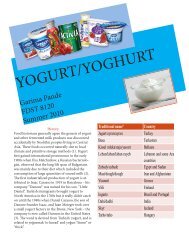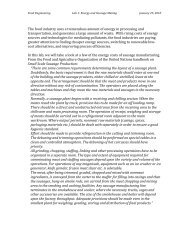Viscometry Lab.pdf
Viscometry Lab.pdf
Viscometry Lab.pdf
You also want an ePaper? Increase the reach of your titles
YUMPU automatically turns print PDFs into web optimized ePapers that Google loves.
FDST 8080 <strong>Lab</strong> 2011<br />
That is, the ratio of viscosity to density is proportional to the time it takes for the liquid to<br />
drop between the marks. The absolute viscosity η can be determined by separately<br />
measuring the fluid density. In some cases it is interesting to determine the “intrinsic”<br />
viscosity of a sample [η], as this can be related to the molecular weight of a dissolved<br />
solute.<br />
Capillary viscometers are of limited use in food systems, as particulate systems can clog<br />
the capillary tube. Also, dependence of viscosity on shear rate or shear history is more<br />
difficult to study. It can be very useful, however for studying clear juices, beverages, or<br />
solutions of food macromolecules such as proteins or carbohydrates.<br />
The time in seconds for the fluid to fall between the two markers is recorded. When<br />
multiplied by the capillary constant k, this gives the kinematic viscosity η/ρ.<br />
V. Juice Viscometer<br />
A variant of the capillary viscometer is the AOAC capillary viscometer for juices (AOAC<br />
37.1.108). It Is more appropriate for fruit nectars and juice products, which may have bits<br />
of pulp and particulates that would clog a precision capillary viscometer.





